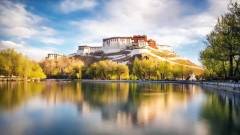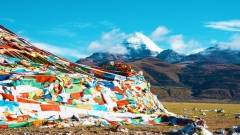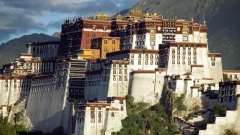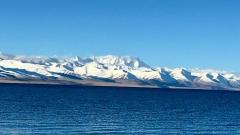Tucked into the high valleys and rugged slopes of the central Himalaya, the Sherpa people are at once ordinary villagers and global icons. For many international travelers “Sherpa” evokes images of rope lines, ladders across crevasses and heroic guides who help climbers reach the world’s highest summits. Yet the Sherpa identity is far richer than mountaineering alone: it is a living culture with deep roots in eastern Tibet, distinctive language and names, resilient agriculture and herding practices, intimate religious life, and a modern economy shaped by tourism and global migration.
Origins and Name: Who Are the Sherpas?
The word “Sherpa” literally means “people from the east” — “sher” (east) + “pa” (people). Oral histories and traditional accounts trace Sherpa origins to the highlands of eastern Tibet (the Kham region). Centuries ago, groups migrated southward across the high passes, settling in the rain-shadowed valleys of what is today northeastern Nepal. Over time these mountain-adapted settlers developed distinct dialects, clan structures and ways of life shaped by altitude, climate and trade with Tibet.
Historically Sherpas combined trading, pastoralism and farming. They exchanged salt and wool for grain, tended yaks and cattle, and raised hardy crops such as potatoes, barley and buckwheat on steep terraces. Over generations they formed clan identities—names and social rules that continue to shape marriage and kinship.
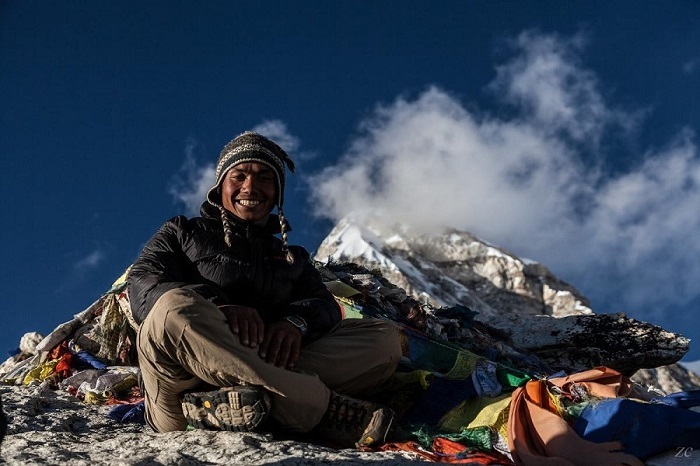
Where Sherpas Live: The Heartland and the Diaspora
Most Sherpas live on both sides of the Himalaya, with the largest concentration in Nepal. Within Nepal their heartland is the Solu-Khumbu district (often called the Everest region), spread along the valleys of the Dudh Kosi and its tributaries. Villages nest between roughly 2,400 meters (8,000 ft) and 4,300 meters (14,000 ft) above sea level: Namche Bazaar, Tengboche, Pangboche and Monjo are familiar names for trekkers.
Beyond Nepal, Sherpa populations appear in Bhutan and Sikkim (India), and smaller groups remain on the Tibetan plateau. Modern migration has created a wider Sherpa diaspora: many families send members abroad for work, and Sherpa guides and climbers travel worldwide.
Sherpas’ Language and Clans
Sherpas speak Sherpa, a Tibetic language closely related to varieties of Tibetan. Most Sherpas are bilingual: Sherpa for home and community life, and Nepali or other regional languages for trade and wider communication. English is increasingly common among guides and younger people connected to tourism.
Traditional Sherpa society includes clan markers. In Nepal, older accounts note four main clan groups—names that reflect historical settlement patterns. Clan rules regulate kinship and marriage: marriage within the same clan is traditionally prohibited, and family names were often kept private historically to protect clans from past persecution. Today, naming practices blend tradition and modernity: many Sherpas still bear given names tied to the day of the week on which they were born (for example, Nima for Sunday, Mingma for Tuesday, Lhakpa for Thursday). Middle names and family identifiers help tell one person from another.
Sherpas Traditional Livelihoods: Farming, Herding and Trade
Life in the high valleys remained carefully adapted for centuries to the short growing season and thin, cold air. Sherpa farmers grow hardy grains and tubers—barley, buckwheat, potatoes—on terraced plots carved into steep slopes. Yaks are central to the high-altitude economy: they provide transport, milk, meat and wool, and their dung is a crucial fuel for winter.
Before mass trekking and climbing, many Sherpas worked as traders linking Tibet and the lower Nepali plains. Salt and wool from Tibet moved across passes in return for grain and manufactured goods, and seasonal migration for trade or herding helped build a flexible subsistence economy.
Sherpas’ Religion and Ritual Life
Sherpa spiritual life is dominated by Tibetan Buddhism mixed with older animist and shamanic elements that predate or accompanied Buddhism’s spread. Most Sherpas follow schools such as Sakya and Karma Kagyu, with pockets of Gelug and Nyingma practice. Lamas hold a respected social role: they lead rituals, offer blessings, and are central to rites of passage.
Local practice is often syncretic—Buddhist liturgy and belief in local spirits coexist. Before major life decisions, families may consult diviners or perform astrological calculations. When someone dies, community rituals aim to guide the deceased toward a favorable rebirth; Sherpas practice cremation or burial, depending on local custom.
Festivals — from Losar (New Year) to local monastery ceremonies and masked dances (cham) — provide the most vivid and communal expressions of belief. These celebrations bring out colorful robes, ritual instruments and elaborate dances that fuse myth, history and social cohesion.
Why Sherpas Excel at High Altitude
Sherpas are renowned for their extraordinary abilities in high-altitude environments. This reputation combines long-term biological adaptation, lifestyle, and specialized mountain skills.
Biologically, generations of life above 3,000 meters have selected physiological traits that improve performance where oxygen is scarce. Typical adaptations include larger lung capacity, efficient oxygen use, and circulatory characteristics that maintain oxygen delivery to vital organs at altitude. Recent genetic research has found specific gene variants in highland populations that support these adaptations, though the details of genetics are complex and evolving.
Beyond biology, lifelong exposure to high-altitude conditions — from childhood play to daily household chores— builds exceptional acclimatization. Sherpa mountaineering knowledge is also technical and cultural: route familiarity, rope and ladder placement, weather reading, and deep experience with glacier travel. These skills, combined with courage and teamwork, make Sherpas invaluable to high-altitude expeditions.

The Mountaineering Era: Guides, Porters and Global Recognition
The modern global story of the Sherpa became inseparable from Mount Everest and Himalayan mountaineering. From the 1920s, Sherpas began assisting foreign climbers—first as porters, later as high-altitude guides and technical partners. The 1953 ascent of Mount Everest by Sir Edmund Hillary and Sherpa Tenzing Norgay marked a turning point: it brought international fame to Sherpas and fixed the image of Sherpas as the indispensable high-altitude workforce.
Today nearly every major expedition to Everest and many Himalayan peaks hires Sherpa staff: high-altitude guides, rope-fixers, icefall experts and support porters. Their work ranges from scouting routes and fixing ladders to carrying loads and establishing camps. This role has delivered significant income to many Sherpa families while also exposing them to risk—avalanche, crevasse falls and severe weather have claimed many Sherpa lives over decades. The sacrifices are part of a complex economic and cultural bargain: the high pay of commercial expeditions supports local schooling, housing and livelihoods, yet safety concerns and equitable compensation remain central issues in the Everest story.
Sherpas Family Life, Homes and Village Life
Sherpa villages present an architecture adapted to mountain life: stone houses with flat or gently pitched roofs, compact courtyards and prayer flags fluttering above. Homes are warm, functional and often centered on family and religious life. Many villages host a gompa (monastery) that functions as a spiritual and cultural hub—places for prayer, community meetings and festival performance.
Daily life blends agricultural chores, animal care, local trade and—today—tourism services. Tea houses and lodges in trekking regions provide guest rooms, meals and a steady income stream in the busy months. Education and health services have improved over recent decades, partly funded by remittances and tourism revenues.
Sherpas Naming, Kinship and Social Rules
Sherpa personal names are distinctive: many include a token that indicates the day of the week of birth—Nima (Sunday), Mingma (Tuesday), Lhakpa (Thursday) and so on. Because several people in a village may share the same day-name, middle names and family names play a role in distinction.
Clan names and surname traditions carry social weight. Historically, some Sherpas kept surnames private to avoid persecution or to preserve clan security. Clan exogamy—marrying outside one’s clan—is a traditional rule; marrying within a clan could result in social sanctions. These customs vary regionally and are changing with modern social mobility and new legal structures.
Sherpas Food, Dress and Everyday Culture
Sherpa cuisine is practical and nourishing for life at altitude. Staples include tsampa (barley flour preparations), potatoes, yak and goat dairy products, and stews rich in vegetables and locally preserved foods. Tea—often buttered yak tea—is central to hospitality and daily warmth.
Traditional dress remains visible in festivals and village life: thick woolen garments, layered robes and ornamented jewelry. Prayer flags, mani stones and small household shrines mark religious devotion and visual identity. Music and oral storytelling preserve history and local legends, while younger Sherpas often mix traditional forms with global influences.
Sherpas Tourism, Economy and Modern Challenges
Tourism—trekking and mountaineering—has transformed many Sherpa communities economically. Income from guiding, porter work, lodges, souvenir trade and remittances pays for schools, clinics and improved housing. Yet this growth brings challenges: environmental pressure on trails and villages, seasonal dependence on foreign visitors, and social change that tests traditional norms.
Tourism also creates opportunities: many Sherpas are now entrepreneurs—running guesthouses, guiding companies, transport services and cultural programs that welcome visitors while keeping decision-making local. Community-based tourism models and Sherpa-owned enterprises are growing, letting benefits stay in the valley.

Sherpa People
Where to Meet Sherpas: Best Places and Experiences for Travelers
For authentic encounters, the Everest region (Solu-Khumbu) is the most accessible. Here are high-value places and experiences:
- Namche Bazaar: The gateway town for Everest; marketplaces, cafes, and acclimatization walks; excellent for meeting guides and learning about Sherpa life.
- Tengboche Monastery: A spiritual center with panoramic views and important festivals; cham dances and pujas occur here.
- Pangboche and Phortse: Traditional villages where older ways of life remain strong and guesthouses are family-run.
- Lukla: The common air gateway to the Khumbu; from here trekkers spread into Sherpa valleys.
- Local festivals: Time your visit for Losar, the Mani Rimdu festival or other monastery-centered celebrations to see cultural displays.
Beyond Nepal, Sikkim and parts of Bhutan host Sherpa communities with slightly different local customs and festival calendars—each place offers a variation on shared Sherpa heritage.
Mysterious Sherpa People of The Himalayas
The Sherpa people are often viewed through the narrow lens of Everest, but their culture encompasses far more: centuries of adaptation, religious depth, agricultural skill and increasingly visible entrepreneurship. Visiting Sherpa villages and monasteries offers a rare chance to connect with life lived at the roof of the world—if that visit is taken with humility, respect and a commitment to leave a positive footprint.
For travelers who want a thoughtfully planned Sherpa-region itinerary that balances cultural immersion, festival timing, and ethical mountain experiences, China Dragon Travel designs custom journeys that prioritize local partnerships, fair employment practices and community-based tourism. We can arrange Sherpa-guided treks, village homestays, monastery visits and educational briefings to ensure your trip honors both the people and the landscape that sustain them.





